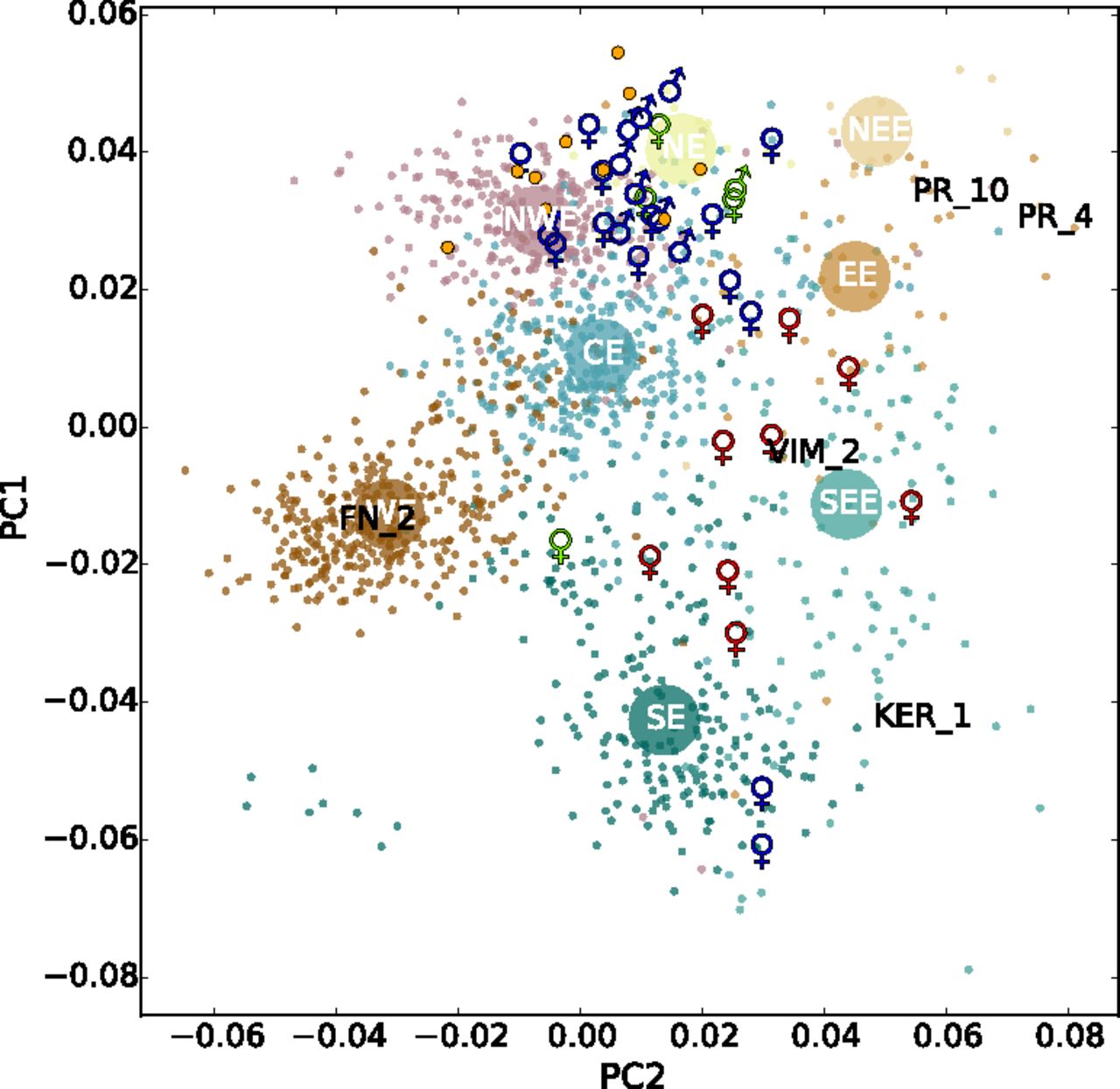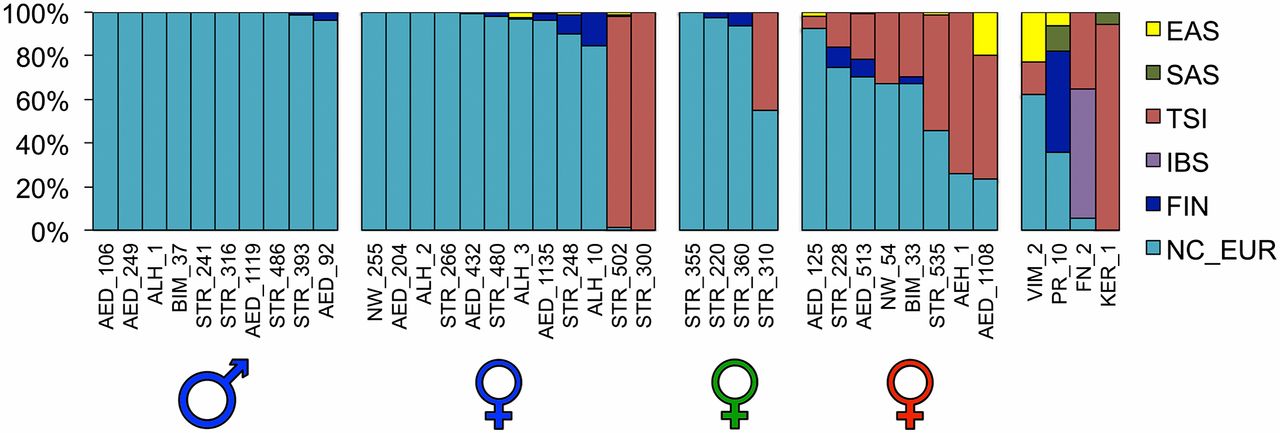New open access paper Population genomic analysis of elongated skulls reveals extensive female-biased immigration in Early Medieval Bavaria, by Veeramah, Rott, Groß, et al. PNAS (2018), published ahead of print.
First, a bit of context on the Bavarii:
Europe experienced a profound cultural transformation between Late Antiquity and the Middle Ages that laid the foundations of the modern political, social, and religious landscape. During this period, colloquially known as the “Migration Period,” the Roman Empire gradually dissolved, with 5th and 6th century historiographers and contemporary witnesses describing the formation and migration of numerous Germanic peoples, such as the Goths, Alamanni, Gepids, and Longobards. However, the genetic and social composition of groups involved and the exact nature of these “migrations” are unclear and have been a subject of substantial historical and archaeological debate
In the mid 6th century AD, the historiographer Jordanes and the poet and hagiographer Venantius Fortunatus provide the first mention of a group known as the Baiuvarii that resided in modern day Bavaria. It is likely that this group had already started to form in the 5th century AD, and that it emanated from a combination of the romanized local population of the border province of the former Roman Empire and immigrants from north of the Danube (2). While the Baiuvarii are less well known than some other contemporary groups, an interesting archaeological feature in Bavaria from this period is the presence of skeletons with artificially deformed or elongated skulls.

Abstract (emphasis mine):
Modern European genetic structure demonstrates strong correlations with geography, while genetic analysis of prehistoric humans has indicated at least two major waves of immigration from outside the continent during periods of cultural change. However, population-level genome data that could shed light on the demographic processes occurring during the intervening periods have been absent. Therefore, we generated genomic data from 41 individuals dating mostly to the late 5th/early 6th century AD from present-day Bavaria in southern Germany, including 11 whole genomes (mean depth 5.56×). In addition we developed a capture array to sequence neutral regions spanning a total of 5 Mb and 486 functional polymorphic sites to high depth (mean 72×) in all individuals. Our data indicate that while men generally had ancestry that closely resembles modern northern and central Europeans, women exhibit a very high genetic heterogeneity; this includes signals of genetic ancestry ranging from western Europe to East Asia. Particularly striking are women with artificial skull deformations; the analysis of their collective genetic ancestry suggests an origin in southeastern Europe. In addition, functional variants indicate that they also differed in visible characteristics. This example of female-biased migration indicates that complex demographic processes during the Early Medieval period may have contributed in an unexpected way to shape the modern European genetic landscape. Examination of the panel of functional loci also revealed that many alleles associated with recent positive selection were already at modern-like frequencies in European populations ∼1,500 years ago.

There is no Y-DNA data to keep confirming the North-Central origin of certain modern European subclades in Central and South-Central Europe.
The potential Ostrogothic sample from Crimea was probably Hunnic, as the paper itself suggests, and both Ostrogoths and Gepids are known to have been allies of the Huns for a long time. It is also a well-known fact that East Germanic tribes migrated south- and eastward through eastern Europe, and then from the steppe westward.
Obviously, the PCA of a late Gepid sample – after a certain number of generations and admixture events with ‘local’ populations during the migrations – , and of a Crimean sample without a clear cultural identification, are of limited value today, until more samples are available.
Hence sadly no valid data yet to add to the debate of East Germanic nature, which mainly concerns its traditionally described origin in Scandinavia – i.e. close to North Germanic dialects – against a different origin (and dialectal branch) within Proto-Germanic territory.
NOTE. Just to be clear for future papers on Germanic tribes, I would expect East Germanic males to show either:
a) mainly R1b-U106, I1, and R1a-Z645 subclades, and to cluster closely to samples of Scandinavia during Antiquity, which would support a Scandinavian origin – a predominance of typically Scandinavian R1a-Z284 subclades would be more indicative of this origin, of course;
b) or mainly R1b-U106, R1b-P312, and I1 subclades and a PCA cluster close to West Germanic tribes, which would challenge its traditional dialectal identification.
I agree with the authors in that a few samples are able to describe certain migratory events, though, such as the emphasized female-biased long-distance migration in Bavaria, as well as the diverse ancestry of women versus men.
Related:
- Germanic tribes during the Barbarian migrations show mainly R1b, also I lineages
- mtDNA suggest original East Germanic population linked to Jutland Iron Age and Bell Beaker
- Admixture of Srubna and Huns in Hungarian conquerors
- The concept of “Outlier” in Human Ancestry (III): Late Neolithic samples from the Baltic region and origins of the Corded Ware culture
- Genetic prehistory of the Baltic Sea region and Y-DNA: Corded Ware and R1a-Z645, Bronze Age and N1c
- Bell Beaker/early Late Neolithic (NOT Corded Ware/Battle Axe) identified as forming the Pre-Germanic community in Scandinavia
- The Tollense Valley battlefield: the North European ‘Trojan war’ that hints to western Balto-Slavic origins
- Heyd, Mallory, and Prescott were right about Bell Beakers